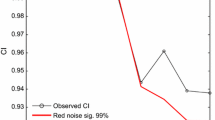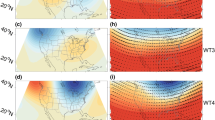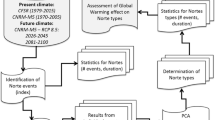Abstract.
We classified 34 years of winter daily 500 hPa geopotential height patterns over the eastern South Pacific-South America-South Atlantic region using the K-means clustering method. We found a significant classification into five weather regimes (WRs) defined as the most frequent large-scale circulation anomalies: WR1 (trough centred downstream of the Drake Passage), WR2 (trough over the SW Pacific and ridge downstream), WR3 (ridge over the SE Pacific and NW–SE trough downstream), WR4 (trough over the SE Pacific and NW–SE ridge downstream) and WR5 (weak ridge to the west of southern South America). We also analysed their persistence and temporal evolution, including transitions between them and development around onsets and breaks of each regime. The preferred transitions, WR1→WR3→WR2→WR4→WR1 and also WR1→WR3→WR2→WR1, suggest the progression of a Rossby wave-like pattern in which each of the regimes resemble the Pacific-South America modes. Significant influence of the WRs on local climate over Argentina was found. The preferred transitions WR1→WR3 and WR3→WR2 induce sustained cold conditions over Patagonia and over northern Argentina, respectively. The most significant change in precipitation frequency is found for WR3, with wetter conditions over all the analysed regions. Finally, the interannual to interdecadal significant variations in the occurrence of these regimes were discussed. WR1 and WR3 are more frequent and WR2 is less frequent during El Niño, and WR2 and WR5 are more frequent and WR1 is less frequent during La Niña. A significant decrease in WR2 and increase of WR4 and WR5 during the 1970s and early 1980s were found.













Similar content being viewed by others
References
Ambrizzi T (1994) Rossby wave propagation on El Niño and La Niña non-zonal flows. Rev Bras Meteor 9: 54–65
Berbery H, Alfaro Lozano L (1991) Características regionales de anomalías de alturas persistentes en los océanos Atlántico y Pacífico Sur. Proc 6to Congreso Argentino de Meteorología, Buenos Aires, September 1991, pp 153–154
Burnett AM, McNicoll AR (2000) Interannual variations in the Southern Hemisphere winter circumpolar vortex: relationships with the semiannual oscillation. J Clim 13: 991–999
Carril AF, Navarra A (2001) Low-frequency variability of the Antarctic circumpolar wave. Geo Res Lett 28: 4623–4626
Chen TC, Yen MC (1997) Interdecadal variation of the Southern Hemisphere circulation. J Clim 10: 805–812
Compagnucci RH, Salles MA (1997) Surface pressure patterns during the year over southern South America. Int J Climatol 17: 635–653
Compagnucci RH, Fornero L, Vargas WM (1985) Algunos métodos estadísticos para tipificación de situaciones sinópticas: Discusión metodológica. Geoacta 13: 43–55
Dole RM, Gordon ND (1983) Persistent anomalies of the extratropical northern hemisphere wintertime circulation: geographical distribution and regional persistence characteristics. Mon Weather Rev 111: 1567–1586
Garreaud RD, Battisti DS (1999) Interannual (ENSO) and interdecadal (ENSO-like) variability in the Southern Hemisphere tropospheric circulation. J Clim 12: 2113–2123
Ghil M, Mo K (1991) Intraseasonal oscillations in the global atmosphere. Part II: Southern Hemisphere. J Atmos Sci 48: 780–790
Grimm A, Barros V, Doyle M (2000) Climate variability in southern South America associated with El Niño and La Niña events. J Clim 13: 35–58
Hurrel JW, van Loon H (1994) A modulation of the atmospheric annual cycle in the Southern Hemisphere. Tellus 46a: 325–338
Kageyama M, D'Andrea F, Ramstein G, Valdes PJ (1999) Weather regimes in past climate atmospheric general circulation model simulations. Clim Dyn 15: 773–793
Kalnay E and Co-authors (1996) The NCEP/NCAR 40-Year Reanalysis Project. Bull Am Meteorol Soc 77: 437–471
Karoly DJ (1989) Southern Hemisphere circulation features associated with El Niño – Southern Oscillation events. J Clim 2: 1239–1252
Kidson JW (1988) Interannual variations in the Southern Hemisphere circulation. J Clim 1: 1177–1198
Kidson JW (1999) Principal modes of Southern Hemisphere low frequency variability obtained from NCEP/NCAR reanalyses. J Clim 12: 2808–2830
Kiladis GN, Mo KC (1998) Interannual and intraseasonal variability in the Southern Hemisphere. In: Karoly DJ, et al. (eds) Meteorology of the Southern Hemisphere. Meteorological Monographs, AMS, Boston, pp 307–336
Kimoto M, Ghil M (1993) Multiple flow regimes in the Northern Hemisphere winter. Part II: sectorial regimes and preferred transitions. J Atmos Sci 50: 2645–2673
Kistler R and Co-authors (2001) The NCEP-NCAR 50-year reanalysis: monthly means CD-ROM and documentation. Bull Am Meteorol Soc 82: 247–267
Malaka I, Núñez S (1980) Aspectos sinópticos de la sequía que afectó a la República Argentina en el año 1962. Geoacta 10: 1–21
Metz W (1987) Transient eddy forcing of low-frequency atmospheric variability. J Atmos Sci 44: 3–22
Michelangeli PA, Vautard R, Legras B (1995) Weather regimes: recurrence and quasi stationarity. J Atmos Sci 52: 1237–1256
Mo K, Higgins RW (1998) The Pacific-South American modes and tropical convection during the Southern Hemisphere winter. Mon Weather Rev 126: 1581–1596
Mo K, White GH (1985) Teleconnections in the Southern Hemisphere. Mon Weather Rev 113: 22–37
Plaut G, Simonnet E (2001) Large-scale circulation classification, weather regimes, and local climate over France, the Alps and Western Europe. Clim Res 17: 303–324
Renwick JA, Revell MJ (1999) Blocking over the South Pacific and Rossby wave propagation. Mon Weather Rev 127: 2233–2247
Robertson A, Ghil M (1999) Large-scale weather regimes and local climate over western United States. J Clim 12: 1796–1813
Rusticucci M, Barrucand M (2002) Climatología de temperaturas extremas en la Argentina. Parte 1: consistencia de datos. Relación entre la temperatura media estacional y la ocurrencia de días extremos. Meteorológica, (in press)
Rutllant J, Fuenzalida H (1991) Synoptic aspects of the central Chile rainfall variability associated with the Southern Oscillation. Int J Climatol 11: 63–76
Simmonds I, Keay K (2000) Mean Southern Hemisphere extratropical cyclone behavior in the 40-year NCEP-NCAR Reanalysis. J Clim 13: 873–885
Solman S, Menéndez C (2002) ENSO – related variability of the Southern Hemisphere winter storm track over the eastern Pacific – Atlantic sector. J Atmos Sci 59: 2128–2140
Thompson DWJ, Solomon S (2002) Interpretation of recent Southern Hemisphere climate change. Science 296: 895–899
Trenberth K, Mo K (1985) Blocking in the Southern Hemisphere. Mon Weather Rev 113: 3–21
Vautard R (1990) Multiple weather regimes over the North Atlantic: analysis of precursors and successors. Mon Weather Rev 118: 2056–2081
Acknowledgements.
This work was supported by ANPCyT Grant 7- 6335, UBACYT Grant 01-X072, ECOS Grant A99U01 and IAI CRN 055. The authors are grateful to Drs. Isidoro Orlanski and Hervé LeTreut for their helpful comments and discussions on many topics of this study. Comments and suggestions by Dr. Hugo Berbery and an anonymous reviewer helped to improve the manuscript. We also thank Sebastien Conil and Bibiana Cerne for technical assistance. NCAR-NCEP reanalysis data were provided through the NOAA Climate Diagnostics Center. Station data were provided by Servicio Metorológico Nacional (Argentina) and Dto. de Cs. de la Atmósfera y los Océanos (UBA).
Author information
Authors and Affiliations
Corresponding author
Rights and permissions
About this article
Cite this article
Solman, S.A., Menéndez, C.G. Weather regimes in the South American sector and neighbouring oceans during winter. Climate Dynamics 21, 91–104 (2003). https://doi.org/10.1007/s00382-003-0320-x
Received:
Accepted:
Published:
Issue Date:
DOI: https://doi.org/10.1007/s00382-003-0320-x




